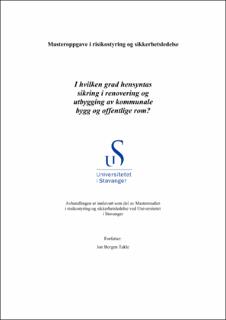| dc.contributor.advisor | Sommer, Morten | |
| dc.contributor.author | Takle, Jon Borgen | |
| dc.date.accessioned | 2023-09-20T15:51:24Z | |
| dc.date.available | 2023-09-20T15:51:24Z | |
| dc.date.issued | 2023 | |
| dc.identifier | no.uis:inspera:137205364:69895753 | |
| dc.identifier.uri | https://hdl.handle.net/11250/3090866 | |
| dc.description.abstract | Kommuner er i forbindelse med sin renovasjon og utbygging av kommunale bygg og offentlig rom rammet av en rekke sektorkrav knyttet til aktiviteten som skal foregå der det bygges. Det kan derfor oppstå situasjoner hvor kommunen er så fokusert på etterlevelse av regelverk at det som er «frivillige» tiltak ikke gjennomføres og får negativ innvirkning på bruken av arealet. Det kan også være at tidsplanen til prosjektet styrer hvilket sikringsfokus som er mulig å ha, hvilken kompetanse innenfor sikring som er i prosjektet/kommunen, struktur for behandling av slike prosjekter i kommunen, risikopersepsjonen til interessentene i kommunen og en rekke andre forhold. Det vil derfor være nyttig å se på i hvilken grad sikringsrisiko blir vurdert, og forhold som påvirker omfang av sikringsrisikovurdering, i byggeprosesser og etterpå. Hensikten med oppgaven er å avdekke forskjeller og bedre forstå hva som er årsaken til vurderingene som gjøres.
Funnene gjort i denne studien indikerer at kommunene i liten grad hensyntar sikring i forbindelse med renovasjon og utvikling av kommunale bygg og offentlig rom. Der hvor kommunen selv etablerer sin virksomhet blir brukerne involvert underveis i prosjektet, men ikke nødvendigvis ressurser som har sikringskompetanse. Med det fremstår det som om sikringsrisiko ikke er tilstrekkelig håndtert i kommunens operasjonelle risikostyring. Funn viser også at offentlige planprosesser for arealregulering i liten grad ivaretar samhandling mellom aktive og passive sikringstiltak i utviklingen, ei heller beskriver verdigrunnlaget for hva som skal sikres eller hvordan den private og offentlige samhandlingen skal fungere. | |
| dc.description.abstract | In relation with the county Vestland in Norway`s renovation and development of municipal buildings and public spaces, municipalities are subject to a number of sectoral requirements. This in related to the activity that will be conducted where construction is taking place. Therefore, situations may arise where the municipality is so focused on compliance with regulations that “voluntary” measures are not implemented and have a negative impact on the use of the area. It may also be that the project schedule governs the possible security focus, the security expertise within the project/municipality, the structure for handling such projects in the municipality, the risk perception of stakeholders in the municipality, and several other factors. It would therefore be useful to examine the extent to which security risk is assessed, and factors that affect the scope of security risk assessment, in construction processes and afterword. The purpose of this task is to uncover differences and better understand what causes the decisions being made. The findings made in this study indicate that municipalities to a small extent consider security in connection with renovation and development of municipal buildings and public spaces. Where the municipality itself establishes its business, users are involved during the project, but not necessarily resources with security expertise. With this, it appears that security risk is not adequately handled in the municipality’s operational risk management. Findings also show that public planning processes for area regulation to a small extent consider interaction between active and passive security measures in development, nor describe the value basis for what needs to be secured or how private and public interaction should work. | |
| dc.language | nob | |
| dc.publisher | uis | |
| dc.title | I hvilken grad hensyntas sikring i renovering og utbygging av kommunale bygg og offentlige rom? | |
| dc.type | Master thesis | |
